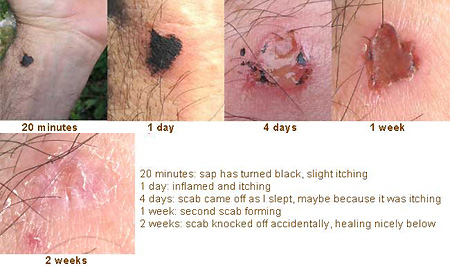
People with experience in the Yucatan know you can't mention Gumbo-Limbo without bringing up the matter of Poisonwood. That's because Poisonwood juice can blister your skin, and Gumbo-Limbo is supposed to be its antidote. Every old Yucatan hand knows, "If you touch Poisonwood (Chechén), you'd better wash with Gumbo-Limbo (Chaká) juice." Moreover, people are likely to swear that wherever there's a Poisonwood tree, there's a Gumbo-Limbo growing not far away. I can swear that it's true that they often share the same habitat, but also that sometimes you get Poisonwood juice on you and there's no Gumbo-Limbo within sight! As you can see below, Poisonwood's pinnately compound leaves look a little like Gumbo-Limbo's.

 Unfortunately for those who want to avoid Poisonwood, the tree's trunk has nothing very distinctive about it, other than that if the trunk is damaged so that it oozes sap, the sap turns black. So, if you run into a tree with black splotches on its trunk, beware. That's one at the right.
Unfortunately for those who want to avoid Poisonwood, the tree's trunk has nothing very distinctive about it, other than that if the trunk is damaged so that it oozes sap, the sap turns black. So, if you run into a tree with black splotches on its trunk, beware. That's one at the right.
To have problems with Poisonwood you need to get the juice on you. Just touching the leaves without injuring them is OK. However, I've heard of people who chopped Poisonwood with machetes, got juice in their eyes, and nearly went blind. It's serious stuff!
In fact, a while back I conducted a little experiment. I broke off a Poisonwood leaf and daubed a single droplet of juice onto the inside of my left wrist. Below, you can see documentation of what happened to my wrist:

Below, you can see a branch of Poisonwood attractively fruiting toward the end of the rainy season in September.

Poisonwood grows throughout the Yucatan. In most places it's uncommon, except along the coast, and there, sometimes, as on a sandbar between a mangrove swamp and the sea, it can be the dominant species.